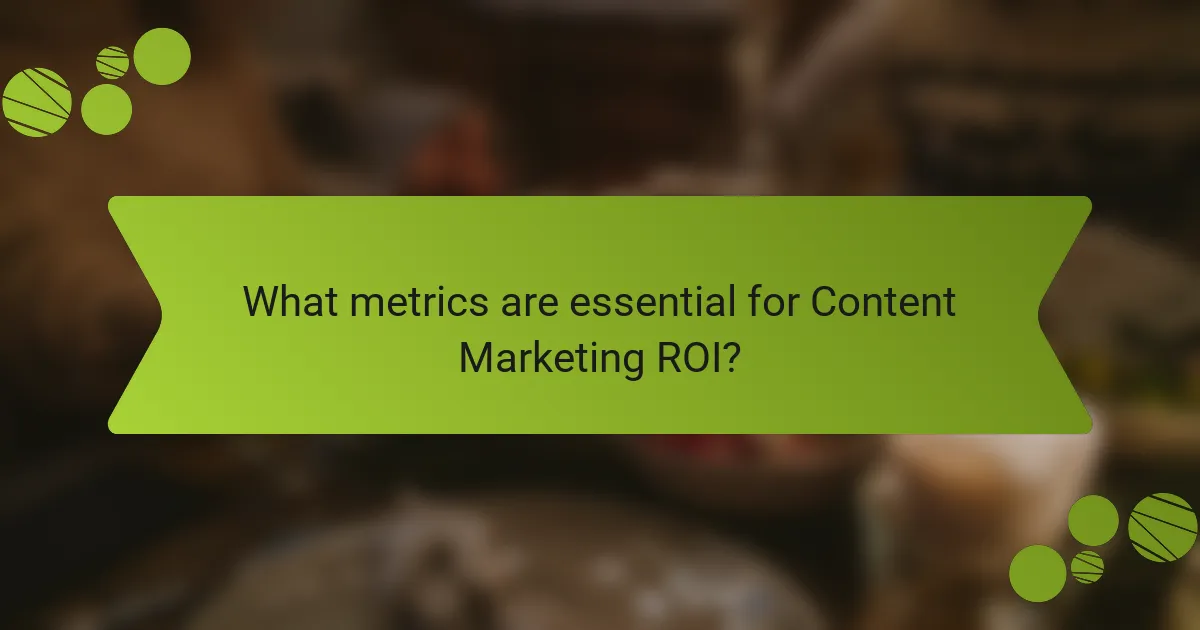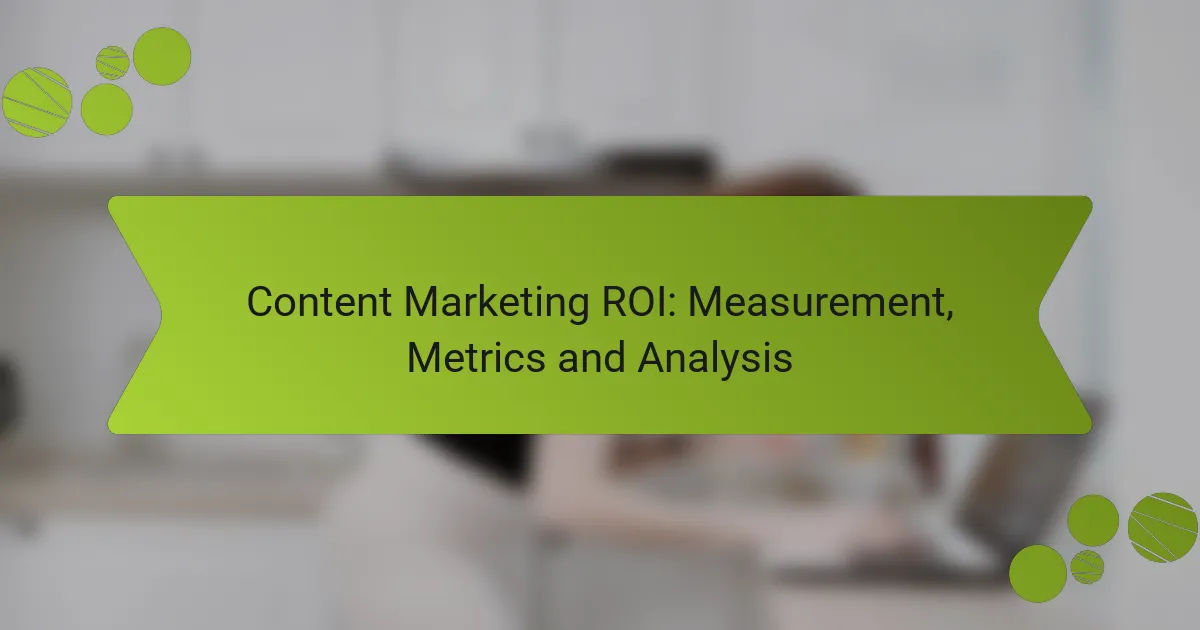Measuring Content Marketing ROI is crucial for understanding the financial impact of content initiatives relative to their costs. By focusing on key metrics such as traffic, conversions, and customer engagement, businesses can evaluate the effectiveness of their content strategies and optimize for better returns. Analyzing these metrics allows for informed decision-making and enhanced marketing efforts.

How to measure Content Marketing ROI effectively?
Measuring Content Marketing ROI effectively involves analyzing the financial return generated from content efforts against the costs incurred. Key metrics include traffic, conversions, and customer engagement, which help evaluate the overall impact of content strategies.
Use of Google Analytics
Google Analytics is a powerful tool for tracking website performance and user behavior. By setting up goals and conversion tracking, you can measure how well your content drives desired actions, such as purchases or sign-ups.
Utilize features like UTM parameters to attribute traffic sources accurately. This helps you understand which content pieces are most effective in attracting and converting visitors.
Implement marketing attribution models
Marketing attribution models help assign credit to different touchpoints in the customer journey. Common models include first-touch, last-touch, and multi-touch attribution, each providing insights into how content influences conversions.
Choosing the right model depends on your business goals and the complexity of your sales process. Multi-touch models often give a more comprehensive view, but they can be more challenging to implement.
Track conversion rates
Conversion rates indicate the percentage of visitors who complete a desired action after engaging with your content. Monitoring these rates helps assess the effectiveness of your content in driving sales or leads.
To improve conversion rates, consider A/B testing different content formats, headlines, or calls to action. Small changes can lead to significant increases in conversions.
Analyze customer lifetime value
Customer lifetime value (CLV) measures the total revenue a customer generates over their relationship with your business. Understanding CLV helps you evaluate the long-term impact of your content marketing efforts.
To calculate CLV, consider factors like average purchase value, purchase frequency, and customer retention rates. This analysis can guide your content strategy to focus on high-value customer segments.
Utilize social media analytics tools
Social media analytics tools provide insights into how your content performs across various platforms. Metrics such as engagement rates, shares, and follower growth help gauge the effectiveness of your social media content.
Tools like Hootsuite or Sprout Social can track these metrics and provide reports that inform your content strategy. Regularly reviewing this data allows you to adjust your approach based on audience preferences and trends.

What metrics are essential for Content Marketing ROI?
Essential metrics for measuring Content Marketing ROI include cost per acquisition, return on ad spend, engagement metrics, and traffic sources analysis. These metrics provide insights into the effectiveness of content strategies and help businesses optimize their marketing efforts for better returns.
Cost per acquisition
Cost per acquisition (CPA) measures the total cost incurred to acquire a new customer through content marketing efforts. This includes expenses related to content creation, distribution, and promotion. A lower CPA indicates a more efficient marketing strategy.
To calculate CPA, divide the total marketing costs by the number of new customers acquired. For example, if you spend $1,000 and gain 50 new customers, your CPA is $20. Aim for a CPA that aligns with your profit margins to ensure sustainability.
Return on ad spend
Return on ad spend (ROAS) evaluates the revenue generated for every dollar spent on advertising. This metric is crucial for understanding the effectiveness of paid content promotions. A higher ROAS signifies a more profitable campaign.
To calculate ROAS, divide the revenue generated from ads by the total ad spend. For instance, if you earn $5,000 from a $1,000 ad investment, your ROAS is 5:1. Businesses typically aim for a ROAS of at least 4:1 to ensure profitability.
Engagement metrics
Engagement metrics assess how users interact with your content, including likes, shares, comments, and time spent on page. High engagement rates often correlate with increased brand loyalty and conversion potential.
Track metrics like average session duration and social shares to gauge content effectiveness. For example, if users spend an average of 3 minutes on your blog post, it indicates strong interest. Focus on creating compelling content that encourages interaction to boost these metrics.
Traffic sources analysis
Traffic sources analysis identifies where your website visitors are coming from, such as organic search, social media, or paid ads. Understanding traffic sources helps you allocate resources effectively and optimize your content strategy.
Utilize tools like Google Analytics to analyze traffic sources. For instance, if 60% of your traffic comes from organic search, consider investing more in SEO. Regularly review and adjust your strategy based on traffic source performance to enhance overall ROI.

How to analyze Content Marketing performance?
To analyze content marketing performance, focus on key metrics that reflect engagement, reach, and conversion. This involves using various methods to gather data, assess effectiveness, and make informed decisions for future strategies.
Conduct A/B testing
A/B testing involves comparing two versions of content to determine which one performs better. For example, you might test different headlines, images, or calls to action to see which generates more clicks or conversions.
When conducting A/B tests, ensure you have a clear hypothesis and a sufficient sample size to achieve statistically significant results. Aim for a testing period of at least a few weeks to account for variations in audience behavior.
Evaluate content reach and impressions
Measuring content reach and impressions helps you understand how many people have seen your content. Reach refers to the total number of unique users, while impressions indicate how many times your content was displayed, regardless of clicks.
Use analytics tools to track these metrics across different platforms. A good benchmark is to aim for a reach that is at least two to three times your total follower count, indicating effective distribution.
Assess audience feedback and surveys
Gathering audience feedback through surveys or comments can provide valuable insights into how your content is perceived. Direct questions about relevance, clarity, and engagement can help identify strengths and areas for improvement.
Consider using tools like Google Forms or SurveyMonkey to create simple surveys. Aim for a response rate of at least 10-15% for meaningful data, and be sure to analyze qualitative feedback alongside quantitative metrics for a comprehensive view.

What frameworks can guide Content Marketing ROI analysis?
Several frameworks can effectively guide the analysis of Content Marketing ROI, helping businesses evaluate the effectiveness of their content strategies. Utilizing structured approaches allows marketers to align their goals with measurable outcomes, ensuring that investments yield positive returns.
SMART goals framework
The SMART goals framework is a widely recognized method for setting clear and achievable objectives in content marketing. SMART stands for Specific, Measurable, Achievable, Relevant, and Time-bound, which helps marketers articulate their goals in a way that facilitates tracking and evaluation.
For example, instead of stating a vague goal like “increase website traffic,” a SMART goal would be “increase website traffic by 20% over the next six months through targeted blog posts and social media campaigns.” This clarity allows for better measurement of ROI as progress can be tracked against specific metrics.
Content marketing funnel analysis
Content marketing funnel analysis focuses on understanding how content influences customer behavior at various stages of the purchasing journey. By analyzing the funnel, marketers can identify which types of content drive engagement, lead generation, and conversions.
Typically, the funnel consists of stages such as awareness, consideration, and decision. For instance, blog posts may attract awareness, while case studies can aid in the consideration stage. Tracking metrics like conversion rates at each stage helps determine the ROI of different content types.
To optimize ROI, marketers should regularly assess which content performs best at each funnel stage and adjust their strategies accordingly. This may involve reallocating resources to high-performing content or experimenting with new formats to enhance engagement.

How does Content Marketing ROI compare across different industries?
Content marketing ROI varies significantly across industries due to differing customer behaviors, sales cycles, and marketing strategies. Understanding these differences is crucial for businesses aiming to optimize their content marketing efforts and maximize returns.
ROI in B2B vs B2C marketing
B2B marketing often sees a longer sales cycle, which can lead to a delayed ROI compared to B2C marketing. In B2B, content marketing focuses on building relationships and educating potential clients, resulting in a more gradual return on investment.
Conversely, B2C marketing typically yields quicker returns as consumers make faster purchasing decisions. Engaging content that resonates with emotions can drive immediate sales, making it essential to tailor strategies accordingly.
Industry-specific benchmarks
Different industries have varying benchmarks for content marketing ROI. For instance, technology and finance sectors often report higher ROI due to their reliance on informative content that establishes authority and trust.
On the other hand, retail may experience lower ROI percentages but can achieve significant volume through effective promotional content. Businesses should analyze their specific industry benchmarks to set realistic expectations and goals.









